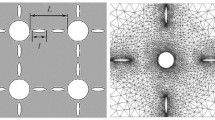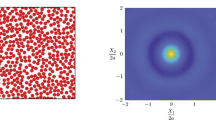Abstract
A nonlinear elastic isotropic body model is proposed to describe the mechanical behavior of a powder composite material with different properties under tension and compression. The composite is considered as a three-phase body with an elastic matrix, throughout the volume of which pores and rigid inclusions are distributed. The unsymmetrical properties of this material are connected with the nucleation of defects, in particular with decohesion or the formation of discontinuities at the matrix—inclusion interfaces.
Similar content being viewed by others
References
R. J. Olsen and G. R. Ansell, “The strength differential in two-phase alloys,” Trans. ASME,69, 711–719 (1969).
F. M. Beremin, “Cavity formation from inclusions in ductile fracture of steel A508,” Metall. Trans.,12, 723 (1981).
S. A. Firstov, A. N. Demidik, I. I. Ivanova, et al., Structure and Strength of Powder Materials [in Russian], Nauk. Dumka, Kiev (1993).
K. Tanaka, T. Mori, and T. Nakamura, “Decohesion at the interface of a spherical, fibre, or disc inclusion,” Trans. Iron and Steel Inst., Japan,11, No. 6, 383–389 (1971).
S. H. Goods and L. M. Brown, “The nucleation of cavities by plastic deformation,” Acta Met.,27, No. 1, 1–15 (1979).
R. Ray and M. F. Ashby, “Intergranular fracture at elevated temperature,” Ibid.,23, No. 6, 653–656 (1975).
D. Broek, “The role of inclusions in ductile fracture toughness,” Eng. Fracture Mechanics, No. 5, 55–66 (1973).
V. V. Skorokhod, Rheological Principles of Sintering Theory [in Russian] Nauk. Dumka, Kiev (1972).
L. D. Landau and E. Lifshitz, Hydrodynamics [in Russian], Nauka, Moscow (1986).
Additional information
Institute of Materials and Mechanics of Machines, Slovakian Academy of Sciences, Bratislava. Institute of Materials Science Problems, Ukrainian Academy of Sciences, Kiev. Translated from Poroshkovaya Metallurgiya, No. 11–12, pp. 69–73, November–December, 1994.
Rights and permissions
About this article
Cite this article
Kudela, S., Shtern, M.B. & Ivlev, Y.A. Model of the nonlinear elastic behavior of a powder composite material. I. Properties of heteroresistant powder materials. Powder Metall Met Ceram 33, 623–627 (1995). https://doi.org/10.1007/BF00559674
Received:
Issue Date:
DOI: https://doi.org/10.1007/BF00559674




